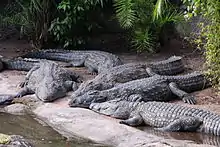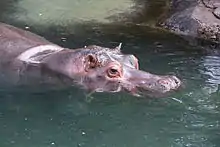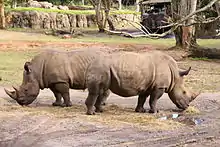Kilimanjaro Safaris
Kilimanjaro Safaris is a safari attraction at Disney's Animal Kingdom on the Walt Disney World Resort property in Lake Buena Vista, Florida. It simulates an open-sided safari ride through the savanna of East Africa.
| Kilimanjaro Safaris | |
|---|---|
 | |
| Disney's Animal Kingdom | |
| Area | Africa |
| Coordinates | 28°21′39″N 81°35′37″W |
| Status | Operating |
| Opening date | April 22, 1998 |
| General statistics | |
| Attraction type | Safari |
| Designer | Walt Disney Imagineering |
| Model | African wildlife safari |
| Music | "Hapa Duniani" by the group African Dawn |
| Site area | 4,791,600 sq ft (445,150 m2) |
| Vehicle type | Safari truck |
| Riders per vehicle | 32 |
| Duration | 22:00 |
| Propulsion | Liquid propane |
Story
The current story is a short photo safari aboard a safari vehicle through the Harambe Wildlife Reserve in Harambe, East Africa. It is 800 square miles (2,100 km2) of natural terrain, including Ituri forest, wetlands of the Safi River valley, and the open bush country of the Serengeti Savanna. African animals on view include real live elephants, giraffes, antelopes, springboks, crocodiles, mandrills, hippopotamuses, lions, cheetahs, hyenas, african wild dogs, warthogs, ostriches, rhinoceroses, storks, pelicans, flamingos, wildebeests, okapis and zebras. The game driver points out animals and provides entertainment. The zebras were removed four months after their arrival due to "acclimation" issues. Some reports claim that the zebras were fighting each other, biting at vehicles or each other, standing in the road, or just causing trouble. They were quickly replaced with addax.
African animals



- Okapi
- Greater kudu
- Saddle-billed stork
- Sable antelope
- Greater flamingo
- Blue wildebeest
- Pink-backed pelican
- Bontebok
- Common eland
- Yellow-billed stork
- Ankole-Watusi
- Mandrill
- Scimitar oryx
- Bongo
- Waterbuck
- Hartmann's mountain zebra
- South-central black rhinoceros
- Southern white rhinoceros
- Hippopotamus
- Nile crocodile
- Masai giraffe
- Warthog
- Ostrich
- Cheetah
- African bush elephant
- Lion
- Spotted hyena
- African wild dog
- Springbok
History

Long before the safari or even Walt Disney World opened, Walt Disney wanted to use real African animals for the river attraction Jungle Cruise at Disneyland.[1] However, for several reasons, Audio-Animatronics replicas were placed instead.
The ride originally included a scripted portion where the safari truck - callsign "Simba-1" - would be contacted by a habitat warden and a scientist to hunt down poachers that had captured a mother elephant and her child - Big Red and Little Red, respectively. The poachers would have been captured at gunpoint by another cast member, a warden. This element of the attraction was eventually eliminated and replaced with scaring off the poachers after a pursuit.
During Cast Previews of Disney's Animal Kingdom, there was a "Dark Ending" in which the safari vehicle encountered the slaughtered corpse of Big Red. She was seen bloody and on the ground with her tusks sawed off, symbolizing the poachers got to her and the tour group was too late to save the mother elephant. Even though it was only an animatronic, this scene proved too shocking for families and children. Many complaints were filed, so before the official grand opening of the ride, Disney removed the dead corpse, thus changing the attraction that of a happier ending.
Kilimanjaro Safaris typically operates until sundown. However, during the holiday season of 1998, the safaris were continued at night and dubbed Kilimanjaro Night Safaris. Though many animals were asleep, or unable to be seen at night, the attraction had a completely different script and storyline. This "new" attraction featured additional animal sounds, reflectors hidden in the foliage to resemble animals' eyes, and an actual African dance troupe, who performed around a bonfire in the area normally occupied by the attraction's elephants. Kilimanjaro Night Safaris only ran during that initial holiday season. After this time, it was deemed that the additional costs, plus the fact that animal visibility was poor (eliciting many guest complaints), made Night Safaris unfeasible to continue regularly.
In 2004, much of the savanna's drainage system had to be replaced. The attraction remained open during the rehab, with green tarps covering the construction sites to keep the animals out.
In 2007–9, the trucks were extended with an extra row of seating, allowing for more capacity. Also, the safari script/story, along with the Wilson/Jobson story has significantly changed. There is less of a story about "Little Red", and more about the animals in the reserve and the need to find a lost elephant at the end. This led to a somewhat confused plot in which guests are searching for a lost "mother elephant" and eventually find her baby which, according to the story, had already been safe the whole time.
In July 2010 it was announced that guests will soon be able to go on "guided treks" around the savanna. This will include areas that are not part of the regular ride experience.[2]
On February 10, 2012 it was announced that the "Little Red" portion of the ride would be replaced with a zebra exhibit. It opened in the fall of 2012.[3]
In 2016, Night Safaris were reintroduced as a part of the expansion of Disney's Animal Kingdom. The nighttime changes included a "sunset," animal sounds, and the introduction of hyenas and painted dogs to the reserve. The ride path was shortened for the night safaris in order to avoid areas where no animals would be visible.
Incidents
- Initially, there were a number of animal deaths from disease, toxic exposure, maternal killings, and park vehicles.[4] The United States Department of Agriculture investigation found no violations of the Animal Welfare Act for the 29 deaths that happened September 1997 – April 1998.[4][5]
- In June 1998, the death of a hippopotamus from probable pneumonia caused a 40-minute closure of the ride.[5]
- In July 2007, a man broke his ankle after jumping out of a ride vehicle.[6]
- In February 2008, a small fire broke out at the front of a ride vehicle. A woman was taken to hospital after jumping from the truck and three other people suffered minor injuries.[7]
Construction
- The attraction features custom-built 1990-2002 GMC Topkicks [8] and Ford Super Duty trucks riding washed-out, rutted roads and a bridge that tilts. The roadbed is actually constructed of dark brown-colored concrete embedded with permanent tire ruts.[9] The vehicles appear to have mud on them, but the "mud" is actually spray painted cement.
- The flamingo island is a huge Hidden Mickey.[10] Other Hidden Mickeys can be found along the ride path.
- Between each ecosystem are both chain road sensors and bars to prevent animals from venturing between sections. The vehicles drive directly on these obstacles.
Facts
- The music snippet heard when driving past the elephant area is called "Hapa Duniani" and is performed by the vocal group African Dawn.
See also
References
- TPMvids (January 7, 2018). Top 10 BEST Disney's Animal Kingdom Secrets! - Walt Disney World (YouTube). Event occurs at 1:29-1:38. Retrieved May 16, 2020.
- Smith, Thomas. New Adventure at Disney’s Animal Kingdom Theme Park will have Guests Trekking into the Savannah. July 15, 2010. Retrieved July 16, 2010.
- Fickley-Baker, Jennifer (2012-02-10). "Kilimanjaro Safaris To Boost Zebra Presence, Add Savannah Space at Disney's Animal Kingdom". Disney Parks Blog. Retrieved 2012-02-11.
- Jon Nordheimer (April 26, 1998). "Disney Goes Live With Its Newest Park". New York Times.
- "Disney Safari Hippo Found Dead". CBS News. Associated Press. June 4, 1998. Retrieved June 12, 2009.
- Minshew, Charles. "Database: Theme park injuries, illnesses and deaths, 2006-present". OrlandoSentinel.com. Retrieved 2018-05-06.
- "Fla.: Fire Closes Ride at Disney's Animal Kingdom". Insurance Journal. 2008-02-12. Retrieved 2018-05-06.
- TPMvids (January 7, 2018). Top 10 BEST Disney's Animal Kingdom Secrets! - Walt Disney World (YouTube). Event occurs at 6:26-6:51. Retrieved May 16, 2020.
- TPMvids (January 7, 2018). Top 10 BEST Disney's Animal Kingdom Secrets! - Walt Disney World (YouTube). Event occurs at 6:59-7:06. Retrieved May 16, 2020.
- Beyond the Kingdoms (April 22, 2020). 15 Animal Kingdom Secrets (YouTube). Event occurs at 8:05-8:35. Retrieved May 16, 2020.
External links
| Wikimedia Commons has media related to Kilimanjaro Safaris. |